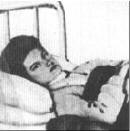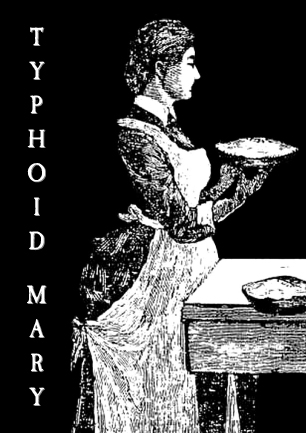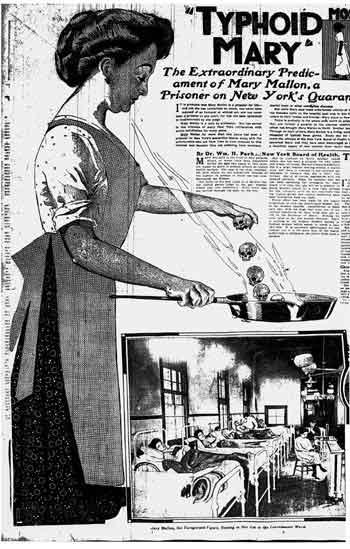HISTORICAL PERSPECTIVES:
Typhoid Mary
Historical Perspective: Typhoid Mary
I've always been struck by the things that terrify people. There have been a staggering number of movies and books that frightened the hell out of the audience by featuring characters trapped in a remote area (all access and communication cut off) hunted by a madman or monster. Yet the possibility of this actually happening are remote (in the case of a madman) or impossible (in the case of monsters). But what are the chances that sometime during our lives a sick stranger will handle our food before we eat it? That's a guarantee. That's something we should really be afraid of. In the United States that fear has a name: Typhoid Mary.
Typhoid Mary's story is one of poverty, disease, science, modernity, personal misunderstandings and stubbornness. It also makes me nervous about eating in restaurants, or even buying food at the store.
Just the Facts:
In the early years of the 20th Century, 47 people (three of whom would die) were infected with typhoid by household cook Mary Mallon. In time Mallon would be America's first identified Asymptomatic Carrier (commonly called a "healthy carrier").
Timeline:
1869- Mary Mallon born, Country Tyrone, Irleand
1883- Like many Irish women poverty forces Mallon to emigrate to the United States
1900- 1906 Mallon works as a cook in New York City. At her places of employment (private homes), Mallon unknowingly
infects two dozen people with typhoid.
1901- Manhattan. Member's of Mallon's employer's family and her coworkers develop fevers and diarrhea. One laundress
dies.
1906- Long Island. Within two weeks of hiring Mallon as a cook, fourteen of twenty family members are ill with typhoid.
Mallon quickly leaves the position. She is eventually identified by George Soper as a healthy carrier.
1908-1911 Mallon is quaratined on North Brother Island at Riverside Hospital. She is released after some media attention
and after she gives her promise not to work in the food industry.
1915- Mallon returns to working as a cook. Using the pseudonym "Mary Brown" she is hired at the Sloan Maternity
Hospital in New York. Twenty-five people are infected, two die. Mallon is returned to quarantine on North Brother
Island.
1915-1938 Mallon remains in quarantine for the rest of her life. She has her own cottage, makes her own meals, is
occasionally interviewed by reporters and works as a lab assistant for a time.
1938, November 11th: Mallon dies of pneumonia. An autopsy reveals live typhoid bacteria in her bladder.

Figures of Note:
Mary Mallon:
Mary was an unassuming person. Nobody where she worked suspected her of being ill or much less of transmitting disease. But, as a healthy carrier, there would have been no reason to believe that there was anything wrong with her. Clearly she never really believed that she giving people typhoid, she always insisted that she had never been sick a day in her life. She may have been lying, but she seems to have been sincere (it's quite possible that she contracted typhoid at a very early age when she was too young to remember, perhaps even getting it from her mother during pregnancy).
In his book Typhoid Mary: An Urban Historical chef Anthony Bourdain argues, convincingly, that Mallon must have have been a good cook to keep getting work. She must have been reasonably likable, employers kept hiring her and coworkers helped hide her when the authorities came to take her away. Given kitchen conditions at the time it seem likely that she kept her work area clean. But her living conditions were called filthy and her personal hygiene criticized as being very poor (at least during her confinement).
She was also strong and determined. When Soper accused her (publicly in the kitchen where she worked) of making people sick Mallon ran him off by brandishing a carving fork (and very strong language). When she was eventually brought in, it took several New York City Police (and Dr. Sara Josephine Baker) to subdue her. Her pride and stubborness goes too far, though. She was never willing to except that she made other people sick. It's easy to see her as a confused victim during her first confinement, but after she insisted on returning to her career in the kitchen (in a maternity hospital of all places) it's hard to give her much sympathy.
Using Mary in a game:
Mary Mallon is one of those real, fallible people rarely found in RPGs. She's not cinematic, if it wasn't for her disease she'd be unremarkable. Which is what makes her an intriguing challenge for a typical group of investigators. There's no genius Moriarty to chase, no fiendish Ripper to foil, there's just one woman. In a story-game Mary may be taken on by a player to be in conflict with the other characters (who may not get along even if they have similar goals).
Even a Historical game doesn't have to utterly imitate the truth. A game may allow you to give Mary a happy ending. She may be given a satisfactory job by one of the characters or perhaps a cure is possible (in a cinematic game).
In a Historical game it will probably be necessary for the GM to change much about the Healthy Carrier so that history buffs don't find her easily.
Pros: Mary is Strong Willed and a Good Cook. Depending on the game, Inconspicuous may also count in her favor.
Cons: Mary is an Immigrant and a Woman (both strikes against her that led Dr. Soper to miscalculate her reaction). The flip-side of her Strong Will is her Stubbornness. Her biggest challenge is, of course, the fact that she is Healthy Carrier of typhoid.
Dr. George Soper:
George Soper was not a medical doctor, he was a sanitary engineer. His goal: to clean up the filth of cities, to make them healthy and livable. He was, as he had been called, a "doctor of sick cities". When all of the likely sources for typhoid had been investigated and excluded, Oyster Bay home owner George Thompson hired Soper to help solve the mystery.
Soper first looked at all of the evidence again, assuming that he'd find an error or missed avenue of investigation. Bad water supply? Tainted dairy? Contaminated shellfish? All dead ends. Soper's great move was to approach this like any other crime. He knew the incubation period for the disease and calculated back to when the disease was introduced to the household. Had there been any odd occurrences? Had different grocers been used? Was there a change in staff?... wait, there had been a change, a new cook who had since left the job! There were only two or three agencies that upstanding families used to hire professional help. He knew he could find her. Once he found this cook he even tailed her back to her rooms. Eventually he even convinced Mallon's gentleman friend to help corner Mary. Soper had successfully reinvented himself has a detective.
Soper's great failing was in his belief that approaching Mary at her place of employment and announcing to all and sundry that she was diseased would gain positive results. It seems entirely possible that a different person, with more foresight and caution, my have found a better solution. Soper's short-sightedness creates two villains: the plague bearing Typhoid Mary and the city hall -backed bully of George Soper. Remember that Dr. Soper wasn't just motivated by the public good, he was more than eager to be the first person to identify a healthy carrier in the United States.
Using Dr. Soper in a game:
Victorian Era games abound with Scientists-as-Heroes. The future is bright (or at least different) and it is men of learning who will lead the day. George Soper is on an admirable crusade, he just wants to make the public healthier, safer. He's inventive but he also has a challenging personality flaw. He would make an interesting character in any RPG. If the game already has a likely medical researching hero then Soper would make a wonderful foil, handled poorly Soper may be come a tenacious enemy but if handled well he could be a potent ally.
Pros: Soper is a Skilled Sanitary Engineer. His successes in his field have given him a Good Reputation. He is at least Clever (if not Inventive), he turns himself into a private detective and even makes the crafty offer of giving Mary Mallon all of the revenues from any book he'd write about her.
Cons: GMs will have to decide how to reflect Soper's shortcoming. Does George underestimate Mallon because he has a Class Bias? Is he Intolerant of Women or Immigrants? Or is he just a Bad at Reading People?
Dr. Sara Josephine Baker:
Admittedly S. Josephine Baker plays a minor roll in the life of Mary Mallon but she is such an interesting person that she deserves at least a mention (she really deserves an article of her own). Dr. Baker was a public health inspector, infant health crusader, received her doctorate from New York University Medical School, started school health and lunch programs, was adept at handling the press, she was an Assistant US Surgeon General, she was the first woman to be a professional representative to the League of Nations, published 5 books and over 200 articles and was romantic partner to writer Ida Alexa Ross Wylie.
Using Dr. Baker in a game:
Baker would make an incredibly interesting character whether a player takes on her roll or if she encountered as an NPC. Either way her personality and her habit of dressing in mannish attire is bound to make an impression.
Pros: Highly Intelligent, Driven, Trained Physician, Famous, Innovative, and Fearless
Cons: Dr. Baker still had to deal with social biases based on her gender and sexual orientation.

Themes and Topics:
Disease is the obvious choice to focus a game on. Disease is everywhere now and in the past. But it's one of the unpleasant things that most games choose to gloss over. Not this time; explore it in full. Make the Characters take a good hard look at the world they live in, at the flood of poverty and disease that flood the "great" cities. Never let the players get comfortable, the longer the game goes on the more the Characters should worry about who they will meet and what they may be carrying.
Mary Mallon's story is also one of personal freedom. Mallon is interred for most of her life without be convicted of a crime, basically without a trial. She was quarantined while dozens of other healthy carriers were allowed to walk free. It's true that this was done for the public good, for the health of the populace. But imagine how terrifying it was for Mallon. She didn't feel sick, yet strangers told her she was and these strangers had the government and police behind them. She was not a criminal so she didn't even get the protections given to criminals. She was kept from everything she knew, from common human contact. Mallon becomes the villain and the victim.
This is also a tale of medical innovation. It's not just the concept of a healthy carrier that was revolutionary, the germ theory of disease was still relatively new. The idea that tiny "animals" caused disease was a controversial idea amongst medical professionals and poorly understood (at best) by the common man. The reason that cities were being cleaned up was because the prevailing theory was that "miasmas" were the cause of sickness, that decomposing filth made "bad air" and this lead to disease. Imagine being a poorly educated person first being told that bacteria transmitted from one person to another caused illness. Then imagine trying to believe that a (seemingly) healthy person could also pass on these germs. Then imagine that doctors tell you that you are the person spreading invisible contagion. Would you believe it?

Game Ideas
The Historical Investigation.
The game follows the basic events of history. Take a large city with an outbreak of a disease. The normal avenues of inquiry turn up nothing. It's now the time for forward thinkers to be brought into play. Characters could include medical doctors, public health officials, detectives (public or private), concerned philanthropists and the head of the plagued household. The game should be run like a classic murder mystery, the only real hitch being that the killer is unaware of the misfortune they're causing.
Not Under My Roof!
Death stalks the city, and the trail leads to the door of a wealthy PC. A self proclaimed "Medical Detective" publicly accuses the one of the Character's Trusted Servants. Will the PC turn in the beloved companion? Will he help the retainer hide? Is it possible that the "Medical Detective" has made an error or that he has ulterior motives?
The Detainees.
The PCs return form a glorious explorations of parts unmapped (the Lost World, Darkest Africa, the Far Side of Mars). But instead of being feted at the docks they are quarantined! The fear is that they've brought more than scientific samples and mounted prey, the Heroes have brought unmentionable plagues. Will the PCs accept their fate quietly? Will they try to make a break for it or will the game revolve around social politics as the Characters pull in personal favors to get released? Perhaps they're being detained for more sinister reasons: has an Arch Nemesis seized the opportunity to embarrass the Heroes or does a business associate need more time to cover his indiscretions?
The Quest.
With an incubation time of several weeks the healthy carrier could stay one step ahead of the PCs for quite some time. There's no rule that says the carrier has to stay in one city. What starts as a simple investigation may quickly turn into continent spanning chase with exotic locales aplenty.
If that doesn't feel right perhaps innovative medical researcher (PC or NPC) has come up with a cure for the contagion. But he needs a team to obtain a rare McGuffin from one of the most dangerous corners of the Earth. The PCs are, of course, the team.
Trailing the Dead.
Like "The Quest" but worse, and by worse I mean with Zombies. Start the game like any hungry dead investigation. The complication is that the instead of being caused by radiation or an unholy relic the zombies are caused by disease. But this time the disease is spread by a healthy carrier. The PCs run around trying to contain the contagion not realize that there's a person somewhere spreading this zombie making infection, a person who seems healthy in every way. With a few weeks head start the contagion could spread incredibly quickly. Imagine "28 Days Later" but with a delayed reaction time. Keep in mind that the healthy carrier doesn't have to be a stranger, he could be one of the investigators, even one of the PCs!
Steampunk.
The essence of "steampunk" is the vindication of discarded scientific theories (like the aether). It's possible to run a campaign where there's no such thing as a healthy carrier, but why stop there? If you really want to radically change the world vindicate the discarded Miasma Theory of Disease.
The idea that microscopic organisms cause disease is proven to be in error (or is never put forth at all). What causes disease? Filth. Dirt. Horrible living conditions. You want to make people healthy? Clean the world. No filth means no disease. Think about how disease free our society would be if all the money we poured into health care was put into sanitation and public cleanliness? What would the future look like?
Strikingly like most early science fiction. The future was always clean and the people distinctly disease free. Now we know it was no coincidence, the Miasma Theory may be the first step towards utopia! Time traveling Victorians may be surprised when they arrive in the future of 2010 to find that disease is a distant memory all because of the high quality of sanitation. (It also explains the weird outfits that future mankind always wears, they must be designed to stay clean!.)
But you can always find a down side. Just because the future is bright and shiny doesn't have to mean it's a good place to be. A time-traveler may find themselves arrested and locked away because they're dirty, grotesquely filthy by the standards of the future. If the Miasma Theory is valid then it's an understandable view! It may be an interesting way to turn things around on time-travelers who are convinced they are heroes who can do no wrong. Especially when they leave outbreaks of disease in their wakes...
Typhoid Mary:
http://en.wikipedia.org/wiki/Mary_Mallon
Typhoid fever:
http://en.wikipedia.org/wiki/Typhoid_fever
Asymptomatic carrier:
http://en.wikipedia.org/wiki/Asymptomatic_carrier
Dr. Sara Josephine Baker
http://en.wikipedia.org/wiki/Dr._Sara_Josephine_Baker
